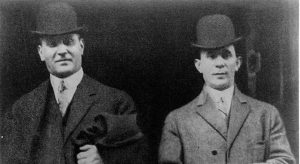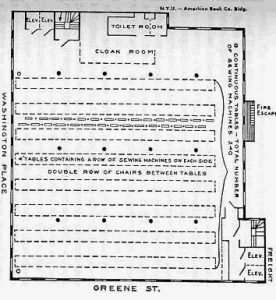Max Blanck and Isaac Harris Start Locking Doors Again
Every bit outrage grew following the tragedy at the Triangle Shirtwaist Mill, the metropolis struggled on where to place blame. While many simply saw the incident every bit accidental–a brutal, yet completely random, disaster–others blamed the oppressive Triangle manufacturing plant owners, besides as the overall norm of worker suppression that was characteristic of sweatshops at the turn of the twentieth century. As the days passed and tensions only continued to grow, a criminal trial commenced. Analyzing the transcript of the trial of Max Blanck and Isaac Harris provides not simply insight into who was to blame, or not to blame, just it also showcases many of the biases and misconceptions that were laid bare following the disaster at Triangle.
The New York City Commune Chaser filed 7 counts of indictment most Harris and Blanck, ane of which was the start caste manslaughter of Triangle worker, Margaret Schwartz. The 13 week trial centered upon the locked Washington Street Door; according to prosecuting attorney Charles S. Bostwick, since the door was illegally locked during working hours, Harris and Blanck therefore acquired the death of Schwartz during the fire.

In his opening statement before a jury of twelve men, Bostwick carefully laid out the charges against Harris and Blanck. To brainstorm, Bostwick thought it wise to "stop for a moment" and provide the jury with a sense of the floor plan (Transcript, 5). Bostwick claimed that, "beside the mere words 'Green Street' and 'Washington Place,'" having some "definite and fixed notion as to the location" was necessary and so "that nosotros may sympathize each other" (Transcript, 5). Bostwick utilized the courtroom itself as visual aid, providing a holistic layout of the ninth floor of Triangle for the jury.

Subsequently grounding the jury within the physical infinite, Bostwick set the scene of the burn down, specifically when the textile workers, including Margaret Schwartz, ran to the locked Washington Place Door: "it is for her death that these defendants are now on trial. Gentleman of the jury, that door was locked. Those who ran to that door cried out 'That door is locked. My God, we are lost.' They were lost. That locked door barred their escape" (Transcript, 10). Bostwick concluded his opening statement laying out the legal precedent for the charges brought against Blanck and Harris: a locked door during manufactory hours was a misdemeanor, and if a decease results from a misdemeanor information technology is deemed manslaughter. Despite the straightforward reasoning, Bostwick'south example brutal completely on whether or non the Triangle Factory owners knew that the Washington Identify Door was locked at the specific moment of the deadly fire. It is on this point that, despite over the ane hundred witnesses and 13 weeks of trial, the prosecution was unsuccessful. While the case of proving that the two defendants knew of a locked door at a specific was already a hard case to prove, it was not made easier by the work of defence chaser, Max D. Steur–a Jewish immigrant and once garment sweatshop worker turned successful, cutthroat defense lawyer (Cornell University–ILR School).
Bias in the Trial
Throughout his often brutal cross-examinations, Steur undermined the words of the surviving Triangle workers, relying on all the biases that made this demographic vulnerable to the oppression of the Triangle sweatshop in the first identify. Their age, gender, status as immigrants, and language abilities were all flaunted throughout the trial, as Steur effectively cast reasonable dubiousness upon the words of the young women in the optics of the all-male person jury.
Steur'southward cross-examinations played on the bias of the stereotypical sweatshop worker at the turn of the twentieth century; his questions were littered with references to, at least what Steur saw, their lack of understanding–"Do I make myself clear to you?", "Practice you understand me entirely?" (Transcript, 373). The defense chaser constantly repeated himself and asked the witnesses to go over details, again and once more, highlighting their accents and potential inability to sympathise the defense attorney, who tried his hardest to talk effectually them and confuse them.
The biases against women, specifically immature immigrant women, played a very important part in the defence's example, particularly in the face of an all-male jury. Throughout the trial, Steur cast dubiety on the women's ability to correctly open the door, implying that fifty-fifty if it had been unlocked, they may potentially have not been able to open it anyway. He asked xviii year old Ida Nelson if she was even aware of what a [door] handle was to which she responded, succinctly: "I know" (Transcript 392). In his cross-exam of Ethel Monick, who had worked at Triangle for three months at the time of the burn, Steur placed more trust in a human being attempting to open up the door than whatsoever of the women working on the ninth flooring: "Tell me then, did a man run over there and blindside on the door and pull at the door and try to open up it, did you see them?" (Transcript, 526). To interrupt the sexist line of questioning, Bostwick went as far as request witness Ethel Monick to pace down and bear witness the court how she was capable of opening the court door, in an attempt to let the record show that the "witness took hold of the handle of the door, and in the presence of the Approximate and jury tried to push and pull the door later turning the handle" (Transcript 486). Steur's attempts to undermine the young women's abilities continued throughout the trial.
Similarly, Steur worked difficult to strike whatsoever emotion that the women expressed on the stand from the tape, attempting to eliminate whatever empathy that the jury may have felt upon hearing their experiences. However, Steur did indicate out, multiple times, the panic that the women on the ninth floor of Triangle experienced during the traumatic fire, coloring information technology as a reaction that clouded their judgement and sent them into hysterics. In his opening argument, Steur stated that, even though "the door was broad open" (engulfed in flames, though he left this out), a policeman "saw two girls in the excited condition that were attempting to leave the edifice by jumping out the window" (Famous Trials). He continued, pointing additionally to the 'excitement' of the women as the reason they could not calm downwards and open up the door correctly, therefore saving their ain lives (Transcript, 526).
Gauge's Remarks and Trial Outcome
Before the jury deliberated, the Estimate of the criminal trial left them with advice, which conceivably swayed the jury toward a verdict of not-guilty. His verbal words were reported in the Literary Assimilate'southward article "146, Nobody Guilty," which was published the following day:
"Because they are charged with a felony, I charge you that before you notice these defendants guilty of manslaughter in the first degree, you must notice this door was locked. If information technology was locked and locked with the knowledge of the defendants, you must also discover beyond a reasonable doubt that such locking caused the death of Margaret Schwartz. If these men were charged with a misdemeanor I might charge you that they demand take no knowledge that the door was locked, just I recollect that in this case it is proper for me to charge that they must accept personal knowledge of the fact that information technology was locked" ( Cornell University — ILR School).
The specificity of the judge's remarks sparked outrage. Jurors, such as Victor Steinman, admitted to existence swayed by his words: "because the judge had charge u.s. that we could not detect them guilty unless we believe that they knew the door was locked and so, I did non not know what to do" (Cornell Academy — ILR School). The jury absolved the Triangle owners of all charges. Harris and Blanck recovered $64,925 in insurance, ultimately clearly a profit of $445 per worker killed in their manufactory'due south fire (McEvoy, 641).
Source: https://courses.bowdoin.edu/history-2203-fall-2020-mburke2/
0 Response to "Max Blanck and Isaac Harris Start Locking Doors Again"
Post a Comment